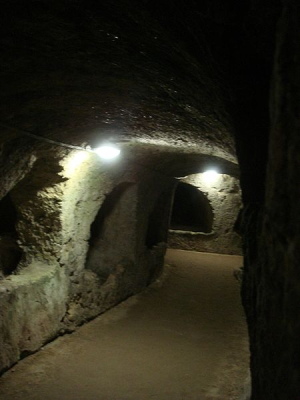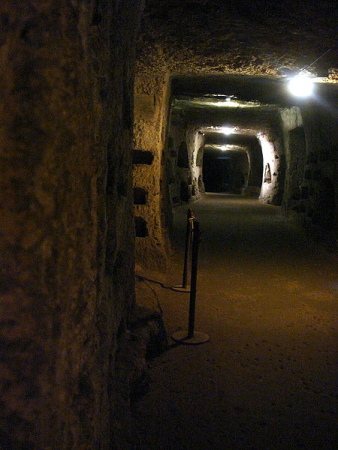
Catacombs of San Giovanni in Syracuse
Along with the Catacombs of Santa Lucia, those of San Giovanni make up the part that is easiest to visit in the whole complex of Syracuse's catacombs, which in terms of expansiveness and articulation are second only to those of Rome.
The atmosphere that permeates this underground
place is extraordinary, full of charm and mystery.
 |
| Arcosolia on a secondary corridor. Catacombs of San Giovanni in Syracuse. |
Contrary to popular belief, burial in catacombs
(or in underground tunnels carved into rock) was not an exclusively Christian
custom, so much so that in Syracuse in the Catacomb
of Vigna Cassia (open for visits by appointment only and only in
large groups) the graves of dead Christians and pagans are located side
by side, apparently linked by ties of kinship and not of religion.
In fact, in Rome there are Jewish catacombs
and pagan catacombs in addition to the better known Christian
catacombs.
To save work, the tunnels in the Catacomb
of San Giovanni of Syracuse were opened initially following the route
of a disused Greek aqueduct (some traces of which are recognizable on the
ceiling of the main gallery), which was expanded to its current dimensions.
Similarly, some existing cisterns along
the route were converted into funeral chapels for families of distinction.
This underground cemetery was built as
mass burial ground even for the poorer members of the population. The rock,
which was easy to work with, made it possible to create, here and in other
Syracusan catacombs, a very particular type of "serial" burial, called
by archaeologists "polysome arcosolium".
These are very long niches in the walls, as wide as a human body and tall
enough to be able to insert a corpse, in which a first body was entombed
with a stone slab, after which in the new space thus created a second corpse
was entombed and sealed by another slab, and so forth.
In these "tunnel-graves" of almost industrial
composition it was possible to lay as many as 30 corpses side by side.
When the space available in this catacomb
was exhausted, they proceeded as best they could, employing every corner
that remained free, on the walls and even on the floor, also invading the
cisterns / chapels, one of which survives filled with the sarcophagi of
a group of nuns from the Byzantine
period.
 |
| View of the main gallery ("decumanus") of the catacombs of San Giovanni in Syracuse. |
It is not difficult for us to imagine the thousands of people who for centuries walked through those tunnels to bring a greeting to a loved one who had passed away. The holes in some surviving tombstones reveal that in this place of Christian burial an ancient pagan ritual survived, the refrigerium, which consisted of pouring through these openings to the deceased, on the anniversary of his or her death, a little wine, milk and honey.
Unfortunately, after thousands of years of looting, what survives is only the "bare bones" of the building, stripped of colored plaster, mosaics, stone slabs (which must have decorated at least the tombs of the richest), and even small objects that were incorporated into the enclosures to distinguish one tomb from another other. The guide on a tour will illuminate and describe some frescoes and inscriptions that have miraculously survived so much hardship, which will make even more regrettable what has been lost.
The few crumbs that escaped the treasure
hunters (they even took marble to burn for making lime) were recovered
by archaeologists in the present era, and are now in the Archaeological
Museum "Paolo Orsi".
Of note above all, a splendid sarcophagus
(richly decorated with biblical scenes in bas-relief) of an aristocratic
lady, Adelfia, survived only because it was hidden in grave dug
into the ground and filled with earth.
From the Catacombs of San Giovanni it is easy to reach the Regional Archaeological Museum, the Papyrus Museum, the Shrine of the Madonna delle Lacrime, and a little further away, the Archaeological Park in Syracuse.
How to reach the Catacombs of San Giovanni
from the Algilà
Ortigia Charme Hotel.
The Catacombs of San Giovanni and the
remains of the church
of San Giovanni Evangelista above are just a few steps from
the Regional
Archaeological Museum "Paolo Orsi" and a short distance from the
Archaeological
Park of Syracuse, off the island of Ortigia.
A route by foot is possible, but it will exceed one kilometer
/ 0.62 miles in distance.
Those who do not have their own transportation
can call a taxi from the reception desk at a special rate or use the bicycles
that the Hotel Algilà offers to its guests for free.
Alternatively, one can take the (free)
shuttle bus #20 from the nearby Piazza
Archimede up to the bus station (near the train station) and
then take either one of the following bus lines: 6, 8, 11, 12 or
13.
Otherwise, from Riva Nazario Sauro (behind
the nearby Piazza delle Poste) one can choose from the following bus lines
1, 2, 3, 4 or 12.
Visitor Information.
The opening and tour of the catacombs
is entrusted to the cooperative
Kairòs.
Visits take place (tickets, € 6 full price,
€ 4 reduced, € 2 educational price, include the cost of the guide) on a
guided tour every 15 to 30 minutes from Tuesday to Sunday, 9:00 a.m.- 12:30
p.m. and 2:30 p.m.-4:30 p.m. (5:30 p.m. in summer). Closed on Mondays.
The guide, well prepared and very courteous
(although sometimes speaking a rather italianate kind of English), provides
an explanation of the history and significance of the site.
Groups led by a cleric can also
book the celebration of a Mass at the crypt
of San Marciano.
For information: Kairòs,
tel. / fax (++39) 0932 64694.
The catacombs are located all on one level with a floor unencumbered by architectural barriers, however, the entrance is via a steep staircase, which does not allow access to people with difficulty walking without proper assistance.
The visit is not recommended for people who suffer from claustrophobia, owing to the absence of an external opening.
Back to TOURISM IN SYRACUSE, SICILY